Overview
This article presents ten essential tips for renting telehandlers in the Dallas-Fort Worth area, emphasizing critical factors such as safety, equipment selection, rental agreements, and cost analysis.
Understanding project requirements is paramount; it ensures that the right equipment is chosen for the task at hand.
Moreover, assessing terrain conditions is vital for operational efficiency.
Clear communication with rental companies significantly enhances satisfaction during the rental process, making it a key element to consider.
Key Highlights:
- EZ Equipment Rental is a leading provider of telehandlers for rent in the Dallas-Fort Worth area, known for quality and customer satisfaction.
- The company offers a wide selection of telehandlers, including compact models for tight spaces and high-capacity units for heavy lifting.
- Demand for telehandlers is growing, with industry reports indicating a significant increase in rental fleets.
- Clients receive personalised assistance to select the appropriate equipment for their specific project needs.
- Safety is prioritised, with a focus on assessing load capacity, reach, and terrain conditions before renting.
- Understanding rental agreements is crucial to avoid disputes, emphasising the need to clarify terms and conditions.
- EZ Equipment Rental is praised for its reliable, well-maintained tools and responsive customer service.
- Renting is often more cost-effective for short-term projects, while purchasing may be beneficial for regular use.
- Customers are advised to book rentals in advance, especially during peak seasons, to ensure availability.
Introduction
The construction landscape in the Dallas-Fort Worth area is undergoing significant evolution, characterized by an increasing reliance on specialized equipment such as telehandlers to meet diverse project demands. As the market for telehandler rentals expands, it becomes essential for contractors and project managers to grasp the nuances of this process. What strategies can be employed to ensure the right equipment is selected, costs are effectively managed, and safety is prioritized? This article explores ten essential tips for renting telehandlers, providing insights designed to empower readers to make informed decisions and enhance their operational efficiency.
EZ Equipment Rental: Premier Telehandler Rental Services in Dallas-Fort Worth
EZ Equipment Rental stands as the premier choice for telehandlers for rent in the Dallas-Fort Worth region, recognized for its unwavering commitment to quality and customer satisfaction. They offer a comprehensive selection of telehandlers for rent, catering to a variety of construction and landscaping needs, featuring compact models for tight spaces and high-capacity units for heavy lifting. Clients benefit from personalized assistance, as the knowledgeable team aids in selecting the right equipment for specific projects, ensuring a seamless experience.
The demand for telehandlers for rent is steadily increasing, with industry leaders observing a notable growth trajectory in the specialty rental market. For example, United Rentals reported a telehandler fleet size of 36,500 in 2025, underscoring a consistent demand in the sector. This trend emphasizes the importance of high-quality tools in efficiently meeting task requirements.
EZ Equipment Rental not only offers competitive pricing but also ensures that clients receive reliable and well-maintained tools. Average rental prices for telehandlers for rent in the DFW region are attractive, making it a cost-effective choice for both short-term and long-term projects. With options ranging from compact models for confined spaces to high-capacity telehandlers for rent designed for heavy lifting, EZ Equipment Rental is well-equipped to address the diverse demands of construction professionals.
Customer satisfaction is of utmost importance, and EZ Equipment Rental consistently garners positive feedback for its responsive service and quality equipment. One satisfied client noted, "EZ Equipment Rental made our task so much easier with their excellent service and the telehandlers for rent that are well-maintained." This dedication to excellence solidifies their status as the preferred supplier for equipment rentals in the DFW metro area.
Evaluate Project Requirements: Determine Load Capacity and Reach
Before leasing telehandlers for rent, it is essential to assess your project's specific requirements. Start by determining the maximum load capacity needed, which can vary significantly based on the materials being lifted. For example, telehandlers for rent, particularly medium ones, typically offer a lift capacity ranging from 6,000 to 15,000 pounds, making them suitable for various construction tasks. Additionally, assess the reach required to lift materials to the desired height; you can find telehandlers for rent that achieve working heights from 4.5 to 16.8 meters, depending on the model. This thorough evaluation guarantees you choose a lift machine that fulfills both weight and reach criteria, ultimately improving efficiency and safety at the work site.
Always refer to the load chart of the equipment, as it details the machine's capabilities and limitations, assisting in accident prevention and ensuring adherence to safety protocols. Understanding these factors is essential; exceeding the lifting capacity can lead to tipping, a significant safety concern in construction environments. Furthermore, it's important to note that using attachments can impact lift capacity, so always check the load chart for these considerations. By taking these steps, you ensure a safer and more effective lifting operation.
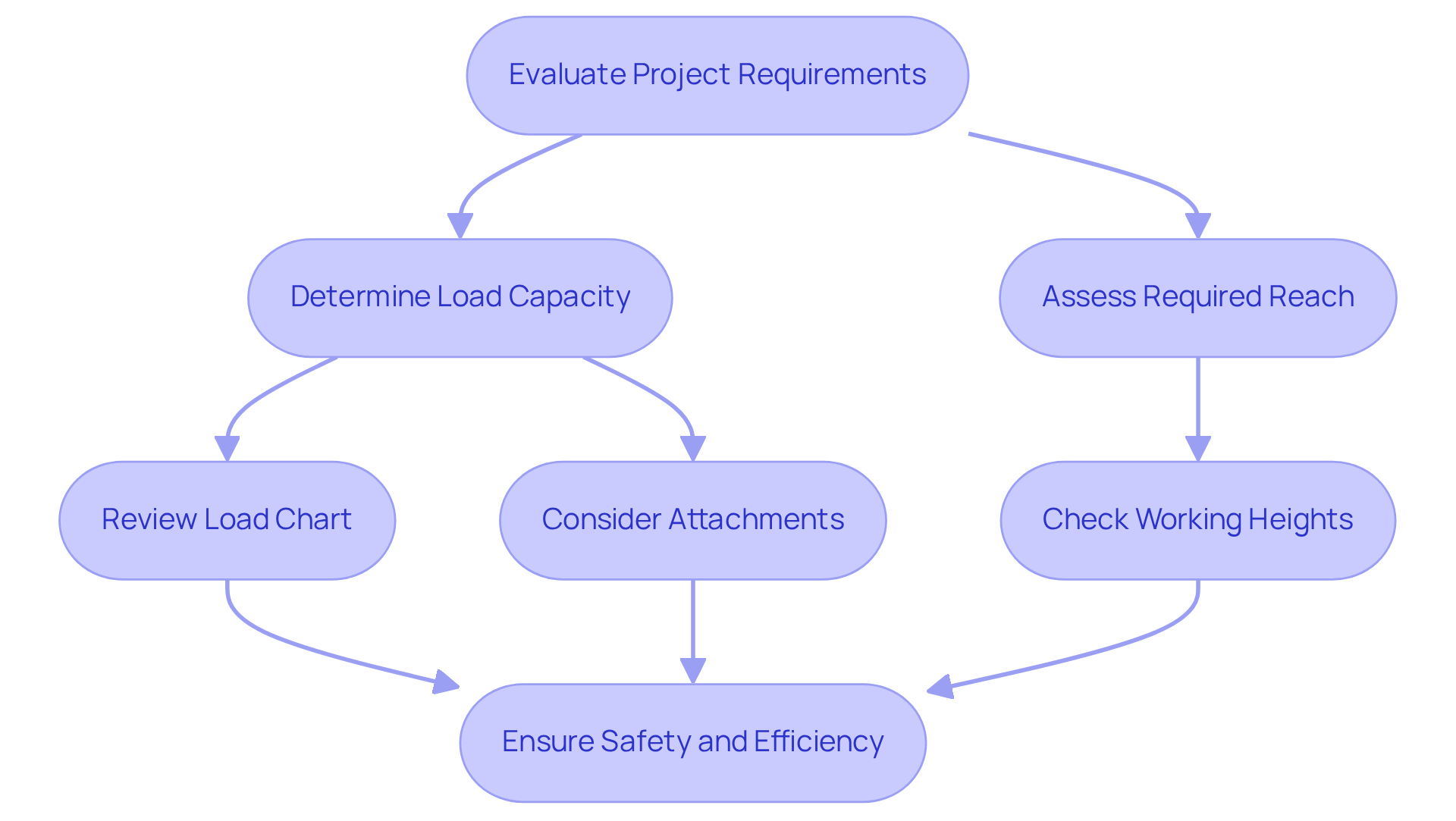
Consider Terrain Conditions: Choose Between Rough Terrain and Standard Models
Selecting the right equipment for your project is crucial and hinges on understanding the terrain it will navigate. For sites characterized by rough or uneven ground, a rough terrain lift, equipped with four-wheel drive and enhanced ground clearance, is indispensable. These features not only boost stability but also improve maneuverability, enabling operators to safely overcome obstacles. Conversely, for mostly flat and paved worksites, telehandlers for rent may be sufficient.
Statistics reveal that rough terrain telehandlers excel in challenging conditions, boasting load capacities that range from 4,500 to 23,000 pounds, depending on the model. At EZ Equipment Rental in Dallas, we provide a diverse fleet, including telehandlers for rent, electric forklifts, and rough terrain forklifts, ensuring tailored access to the precise tools you need.
The successful use of these telehandlers in construction and agriculture exemplifies their versatility, especially in settings where standard models may falter. By carefully assessing terrain conditions and ensuring that operators are well-versed in safety protocols, you can secure optimal performance and safety, ultimately leading to a more efficient execution of your project.
For all your material handling needs, consider EZ Equipment Rental to access specialized tools that significantly enhance your project's productivity and safety.
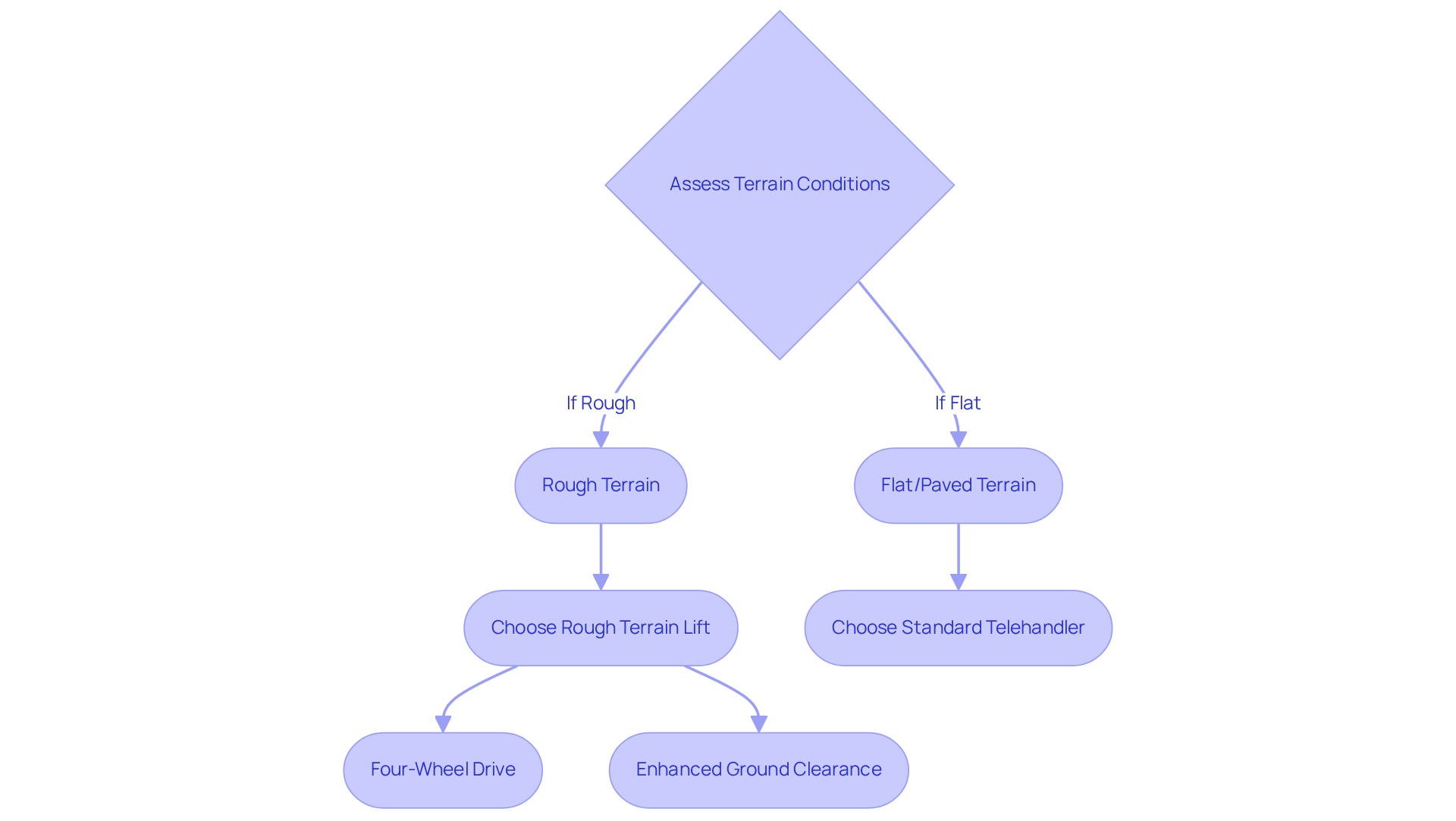
Select Suitable Attachments: Enhance Functionality with Specialized Tools
To maximize the efficiency of your lifting equipment, selecting the right attachments is crucial for enhancing functionality. Common attachments include:
- Forks for lifting pallets
- Buckets for moving loose materials
- Truss booms for reaching elevated areas
By utilizing these specialized tools, you can adapt the lift vehicle to a variety of tasks, thereby boosting productivity and minimizing the necessity for multiple pieces of equipment. For instance, forklift attachments can improve productivity by enabling operators to handle loads weighing up to 75,000 pounds. Industry specialists emphasize that pairing the appropriate attachment with the task at hand not only maximizes the equipment's advantages but also contributes to a safer and more effective job site.
Furthermore, options such as:
- Grapple buckets for demolition
- Augers for post-hole drilling
can significantly enhance the capabilities of your lifting machine. Additionally, equipping telehandlers for rent with a universal skid steer adapter simplifies the connection and disconnection of attachments, further streamlining operations. Understanding the various categories of attachments—buckets, carriages, truss booms/lift hooks, and specialty attachments—will ensure that your construction projects progress smoothly and effectively.
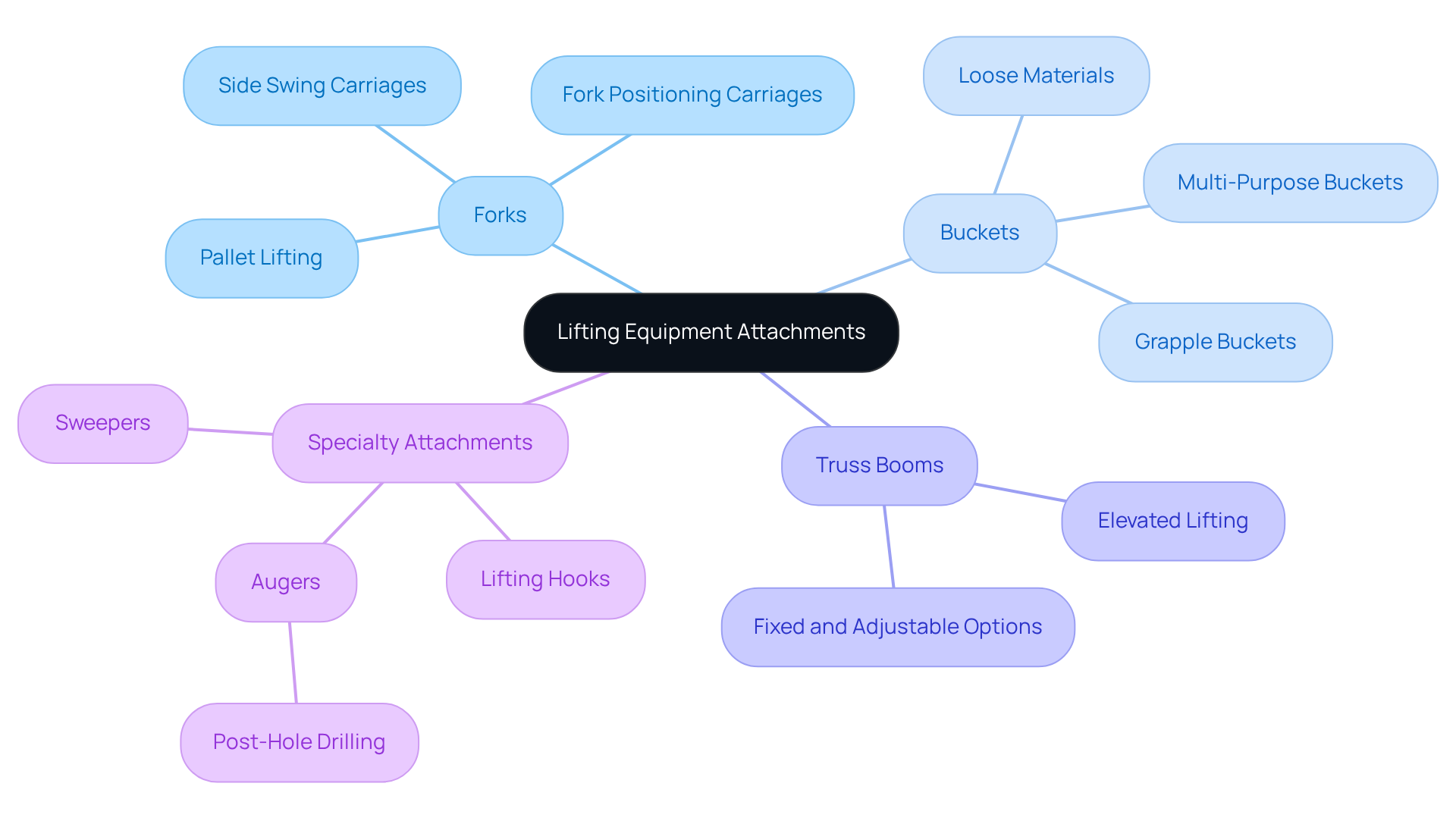
Compare Rental Costs: Analyze Pricing Structures and Hidden Fees
When leasing telehandlers for rent, conducting a thorough comparison of costs across various providers is essential. Analyze the pricing structures, which typically include daily, weekly, and monthly rates, and pay close attention to potential hidden fees that could impact your budget. Common hidden costs may include:
- Delivery charges
- Insurance fees
- Fuel surcharges
These can significantly raise the overall expense of the lease. For example, numerous lease contracts necessitate tenants to return the items with a full tank of fuel or incur an additional charge. Furthermore, some providers may impose fees for specialized attachments or equipment modifications, which are frequently not incorporated in the base leasing cost.
By thoroughly examining lease contracts and inquiring about what is included, you can prevent unforeseen expenses and choose a leasing option that fits both your budget limitations and project needs. Grasping these subtleties not only aids in effective budgeting but also guarantees a smoother leasing experience.
Moreover, considering that the typical expense of a single lost-time injury on a construction site is around $35,000, it becomes essential to consider all possible costs linked to leases, including concealed charges. Understanding seasonal demand for telehandlers for rent can also affect pricing and availability, enabling project managers to plan more efficiently. Always read the lease agreements thoroughly to avoid unexpected charges and ensure clarity on all terms.
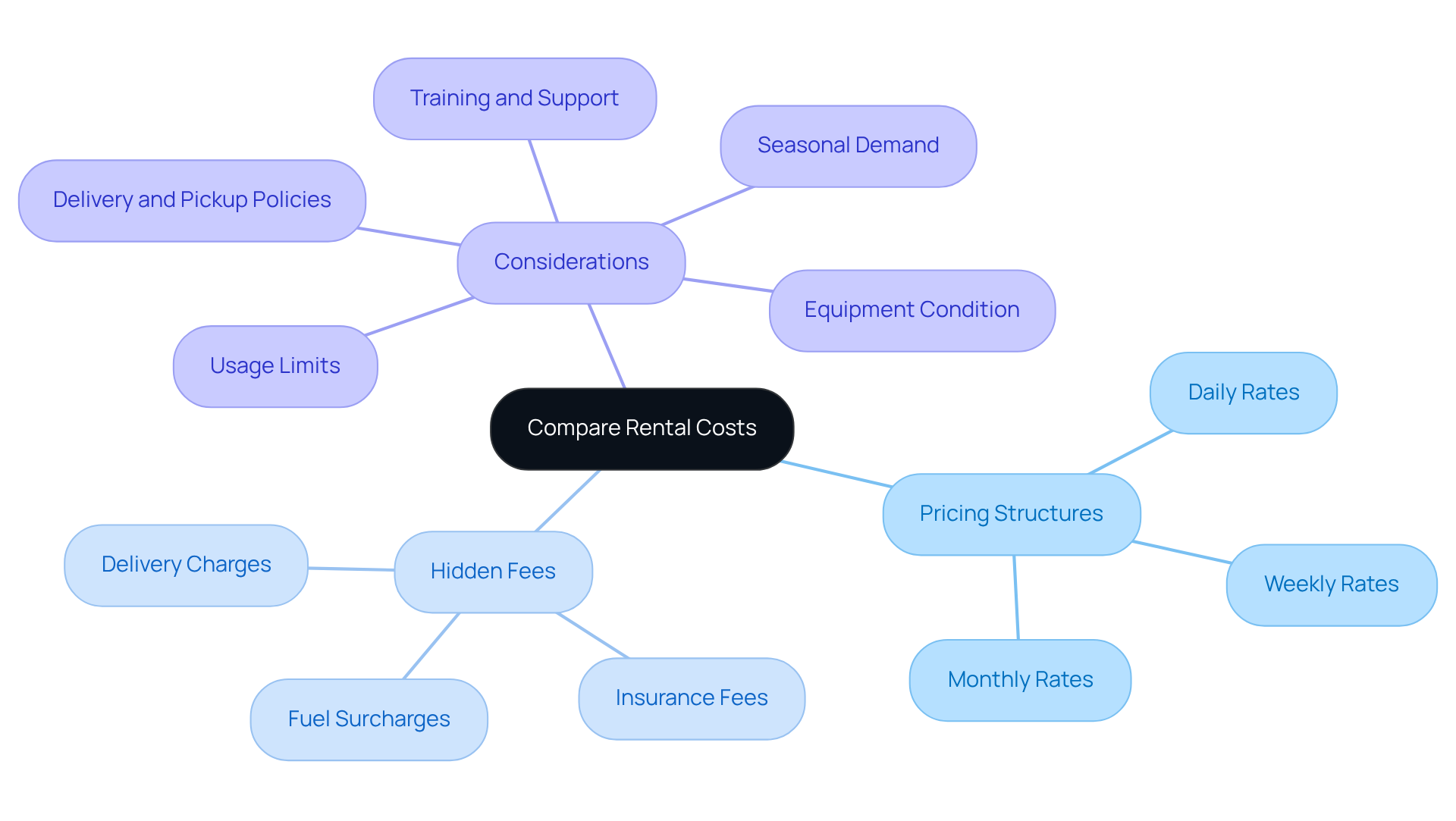
Check Availability: Book Telehandlers Ahead of Time for Peak Seasons
To ensure access to the telehandlers for rent you require, particularly during peak construction seasons, it is crucial to book your rental well in advance. During busy periods, demand for telehandlers for rent often surges, leading to limited availability and potential delays. Construction supervisors consistently emphasize the importance of proactive planning; one noted, 'Acquiring tools early is vital to maintaining our tasks on schedule.'
Projects that have faced delays due to supply shortages underscore the risks of waiting until the last moment. By arranging your rental ahead of time, you not only secure the necessary tools but also minimize the risk of disruptions that could derail your schedule.
In the DFW area, including Irving, EZ Equipment Rental provides a comprehensive selection of equipment such as:
- Boom lifts
- Excavators
- Forklifts
The average lead time for booking telehandlers for rent is typically a few weeks, making early reservations a strategic move to boost project efficiency and success.
Understand Rental Agreements: Clarify Terms and Conditions Before Signing
Before entering into a leasing agreement, it is crucial to meticulously review and comprehend the terms and conditions. Focus on key elements such as:
- Lease duration
- Payment terms
- Maintenance responsibilities
- Liability clauses
Notably, statistics indicate that nearly 30% of leasing contracts lead to disputes, often stemming from misunderstandings regarding these very details, including damages. By clarifying these aspects upfront, you can significantly reduce the risk of conflicts and ensure a smooth leasing experience. Legal experts emphasize that transparency in contract terms fosters trust between parties. B. Heath Witzen observes, "Clarity in the terms and conditions of equipment leasing agreements is essential for building trust between parties."
Therefore, it is essential to ask the leasing company for clarification on any ambiguous points. Common clauses in agreements for telehandlers for rent often include:
- Maintenance responsibilities
- Liability limitations
- Payment terms
Successful leasing experiences depend on well-defined agreements, so take the time to ensure that all terms are clear and understood before signing. Always request a copy of the rental agreement in advance to review all terms before signing.
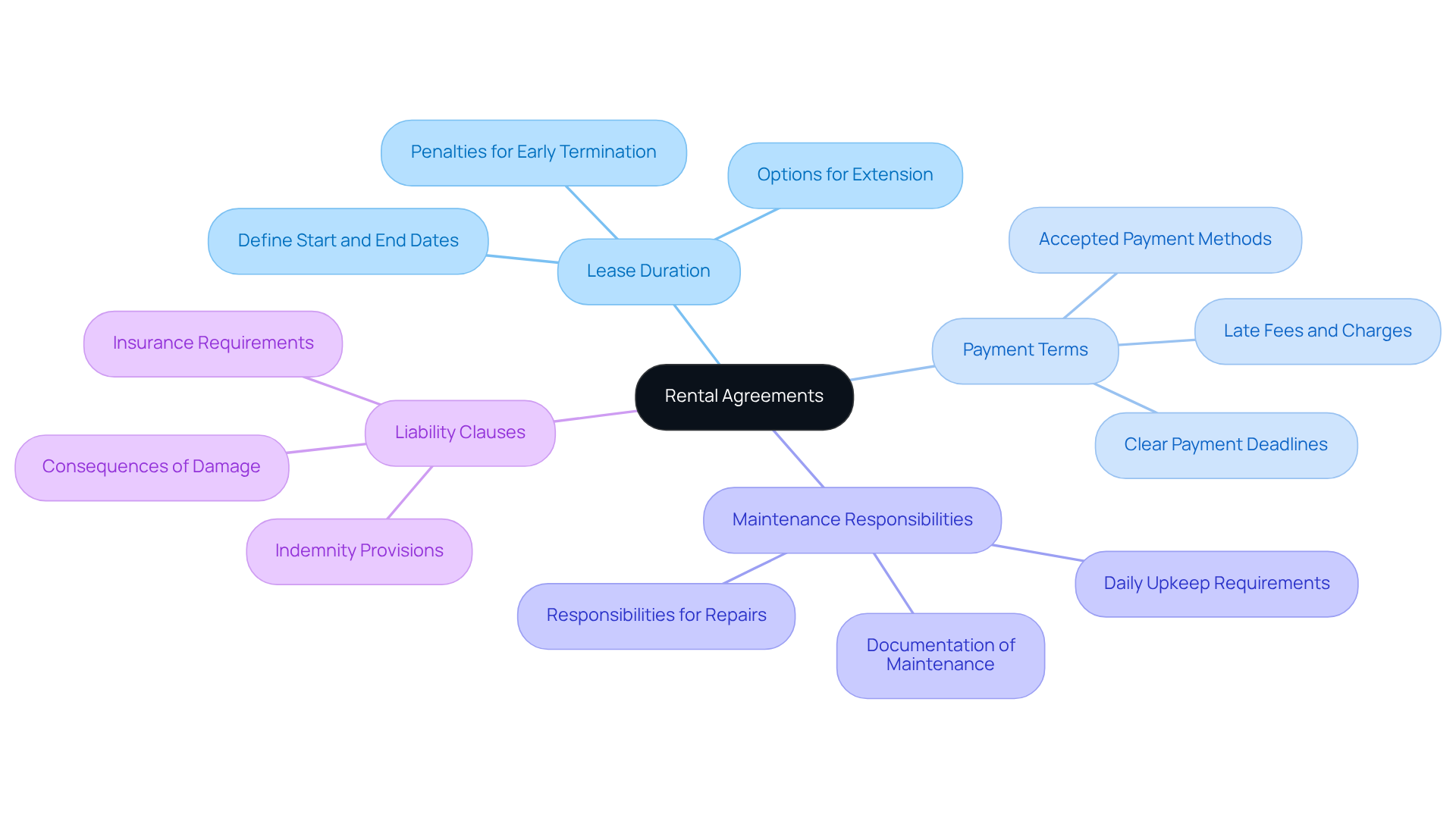
Prioritize Safety: Assess Safety Features and Training Requirements
When renting a material handler, prioritize safety by thoroughly assessing the equipment's safety features and understanding the training requirements for operators. Essential safety features such as load sensors, stability indicators, and emergency shut-off systems are crucial; they not only protect operators but also significantly enhance safety on construction sites. Furthermore, it is imperative to verify that operators have obtained adequate training and certification to operate the equipment safely. This step is essential for avoiding accidents and ensuring strict adherence to safety regulations.
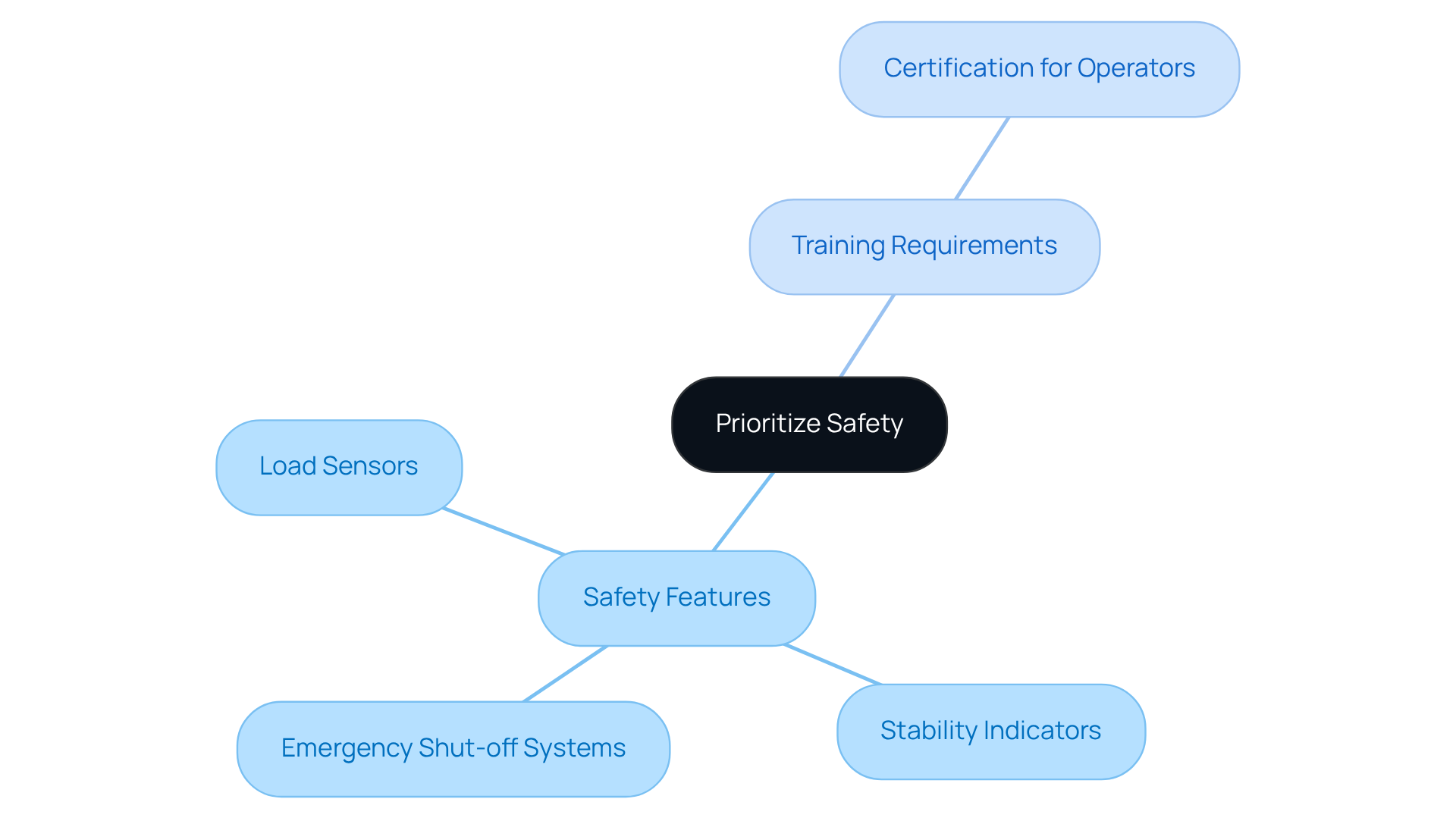
Research Rental Companies: Evaluate Reputation and Customer Support
Before entering into a lease for telehandlers for rent, it is imperative to conduct thorough research on potential leasing companies. Begin by evaluating their reputation through customer reviews and testimonials, particularly those from EZ Equipment Rental in Dallas, Texas, recognized for its exceptional service quality. A trustworthy leasing firm must demonstrate attentiveness to inquiries, provide clear information about their tools, and offer continuous support throughout the leasing process. EZ Equipment Rental sets itself apart through its commitment to client satisfaction, as reflected in the positive reviews from customers who appreciate their approachable support and well-maintained tools.
Studies indicate that companies with robust customer support experience a significant boost in client satisfaction and repeat business; effective customer service can lead to a 20-40% increase in retention rates for leases. Moreover, considering the challenges of machinery downtime and maintenance in the industry, having a reliable support system becomes even more critical. Utilizing CRM systems can further enhance customer interactions, ensuring that all inquiries are addressed efficiently. By selecting a dependable provider like EZ Equipment Rental, you not only elevate your rental experience but also secure access to high-quality telehandlers for rent that meet your needs.
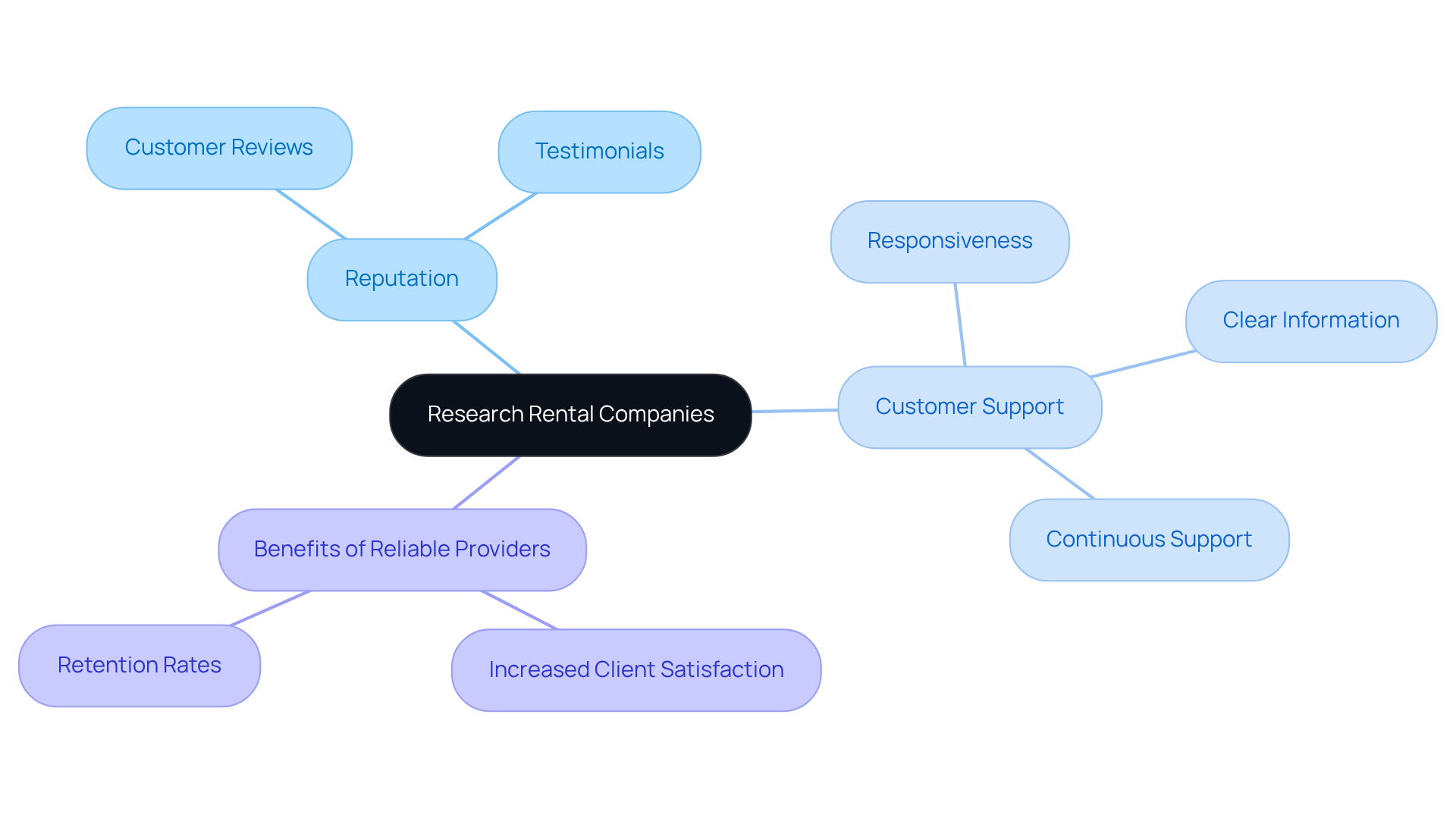
Weigh Renting vs. Buying: Assess Long-Term Value and Cost-Effectiveness
When deciding between renting and purchasing a lifting machine, it is crucial to evaluate the long-term value and cost-effectiveness of each option. Leasing telehandlers for rent often proves advantageous for temporary projects or infrequent use, as it eliminates the substantial initial investment and ongoing maintenance costs associated with ownership. For instance, using telehandlers for rent can significantly reduce labor costs by up to 30% and improve efficiency by as much as 40%, making them ideal for short-term assignments.
Conversely, if your operations require a telehandler on a regular basis, purchasing may provide greater long-term value. Ownership facilitates customization and ensures consistent availability, which can be essential for sustained operations. Financial experts frequently recommend a thorough assessment of your needs, budget constraints, and usage frequency to determine the most economical approach.
For example, a construction company engaged in multiple projects over several months may discover that the total rental expenses surpass the purchase price, particularly when factoring in potential resale value. In contrast, a business with sporadic requirements might find that the flexibility and lower upfront costs of renting telehandlers for rent are more beneficial. Ultimately, a meticulous evaluation of your unique circumstances will lead you to the optimal decision regarding telehandler acquisition.
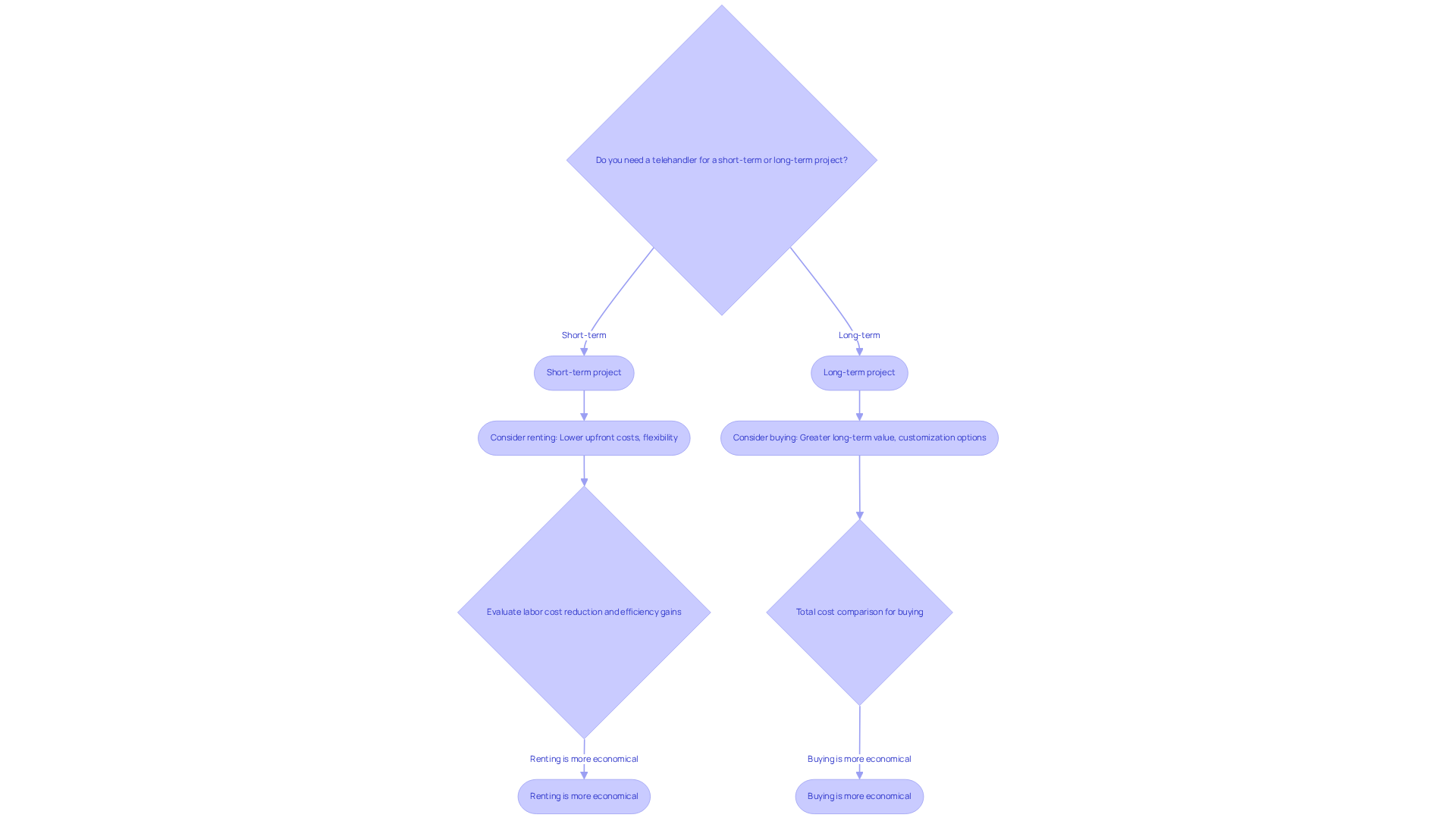
Conclusion
EZ Equipment Rental offers essential insights into the critical considerations for renting telehandlers in the Dallas-Fort Worth area. By grasping the intricacies of the rental process—from assessing project requirements to ensuring safety and evaluating rental agreements—clients can make informed decisions that significantly enhance productivity and efficiency on construction sites.
Key considerations include:
- Evaluating load capacity and terrain conditions when selecting telehandlers.
- Understanding the advantages of choosing the right attachments to maximize functionality.
- Comparing rental costs and understanding rental agreements.
- Prioritizing safety features and training for operators.
By addressing these factors, renters can sidestep common pitfalls and ensure a seamless rental experience.
Ultimately, the importance of thorough research and proactive planning cannot be overstated. By selecting a reputable provider like EZ Equipment Rental and adhering to the outlined tips, project managers can secure the right equipment for their needs, streamline operations, and contribute to the success of their projects. Embracing these best practices will not only enhance project efficiency but also foster a safer working environment, positioning the telehandler rental process as a strategic advantage in the competitive construction landscape.
Frequently Asked Questions
What services does EZ Equipment Rental offer?
EZ Equipment Rental provides telehandler rental services in the Dallas-Fort Worth region, featuring a comprehensive selection of telehandlers for various construction and landscaping needs, including compact models for tight spaces and high-capacity units for heavy lifting.
Why is there an increasing demand for telehandlers?
The demand for telehandlers is on the rise due to the consistent growth in the specialty rental market, with industry leaders noting significant increases in fleet sizes, such as United Rentals reporting a telehandler fleet of 36,500 in 2025.
What are the average rental prices for telehandlers in the DFW region?
The average rental prices for telehandlers in the DFW region are competitive, making it a cost-effective choice for both short-term and long-term projects.
How can clients ensure they select the right telehandler for their project?
Clients can ensure they select the right telehandler by evaluating their project requirements, specifically determining the maximum load capacity needed and the reach required to lift materials to the desired height.
What is the typical lift capacity of medium telehandlers?
Medium telehandlers typically offer a lift capacity ranging from 6,000 to 15,000 pounds, suitable for various construction tasks.
What should clients consider regarding terrain conditions when renting telehandlers?
Clients should consider whether the terrain is rough or uneven, as rough terrain telehandlers are equipped with features like four-wheel drive and enhanced ground clearance, which improve stability and maneuverability.
What are the load capacities of rough terrain telehandlers?
Rough terrain telehandlers have load capacities ranging from 4,500 to 23,000 pounds, depending on the model.
How does EZ Equipment Rental ensure customer satisfaction?
EZ Equipment Rental focuses on customer satisfaction by providing responsive service and well-maintained equipment, consistently receiving positive feedback from clients.
What safety considerations should be taken into account when using telehandlers?
It is essential to refer to the load chart of the equipment, which details the machine's capabilities and limitations, to prevent accidents and ensure adherence to safety protocols. Exceeding lifting capacity can lead to tipping, which is a significant safety concern.




